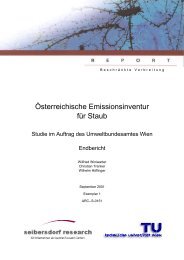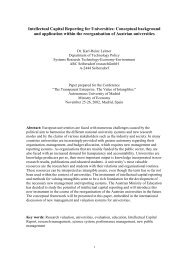ALPMON FINAL REPORT - ARC systems research
ALPMON FINAL REPORT - ARC systems research
ALPMON FINAL REPORT - ARC systems research
Create successful ePaper yourself
Turn your PDF publications into a flip-book with our unique Google optimized e-Paper software.
Contract ENV4-CT96-0359 <strong>ALPMON</strong><br />
surface model, thus indication surface roughness as a critical parameter for potential avalanche<br />
release, and combining it with satellite image classification of the land cover.<br />
The third field of application is concerning the modelling of water run-off. The ASGI model, on which<br />
one of the <strong>ALPMON</strong> feasibility studies was based, is tested and applied to a test site in western Styria<br />
in close co-operation with Mr. Molnar (Ingenieurbüro für Umweltmanagement u. Wasserwesen) who<br />
was involved in the development of the ASGI model. The meteorological input parameters will be<br />
further improved and the model further tested in the Styrian test site. It is expected that this model can<br />
significantly support the Styrian government with respect to the support of the Styrian flood warning<br />
system.<br />
A main task of Joanneum Research will be to introduce the remote sensing based Alpine Information<br />
System to the Alpine Convention, following the outlined methods as described in this report.<br />
WSL<br />
Furthermore at WSL, <strong>ALPMON</strong> serves as a knowledge basis for the examination of a remote-sensingbased<br />
national landscape inventory, which is intended to replace, in a long-term perspective, the<br />
existing national forest inventory (LFI). WSL is responsible for the development of new methods for this<br />
purpose.<br />
LMU<br />
First of all the application of the ASGI water run off model in the Mangfall test site is planned for the<br />
next future. Precondition for this is that the ASGI model is running stable on the LINUX platform with<br />
the GRASS GIS software configuration as implemented during the last year.<br />
The results of the <strong>ALPMON</strong> classifications as well as the <strong>ALPMON</strong> GIS data base of the Mangfall test<br />
site should be delivered to the Forest Offices Schliersee and Kreuth. At this Forest Offices the<br />
introduction of digital data handling is planned for the next month.<br />
In the frame of the EU funded Interreg 2 project “Landeskulturelle Leistungen des Bergwaldes” the<br />
<strong>ALPMON</strong> classification results have been used for the predefinition of the ground truth design.<br />
The Sections for Redevelopment of Barrier Woodland (Funktionsstellen Schutzwaldsanierung) of the<br />
Bavarian State Forest Administration plans to use the results of <strong>ALPMON</strong> for restoration planning<br />
purposes.<br />
RSDE<br />
Methodologies for the assessment of alpine erosion risk based on remote sensing are expected to be<br />
of great interest for several potential customers in Italy because the Italian alpine area involves five<br />
regions (Piemonte, Valle d’Aosta, Lombardia, Veneto, Friuli-Venezia Giulia) and two autonomous<br />
provinces (Bolzano, Trento), accounting for 15% of the national surface and nearly 20% of the whole<br />
alpine area, and playing a primary role on local economy. The issues of the erosion risk feasibility<br />
study represent a sound basis to develop effective demonstrations to rise the interest of regional public<br />
administrations toward the remote sensing approach to the preservation of alpine environment.<br />
However it must be considered that, while the <strong>ALPMON</strong> land cover parameters selected for the erosion<br />
risk application have a general validity over the Alps, the type and quality of auxiliary data (DEM,<br />
geomorphology, geology, soil, climate) are very heterogeneous among Italian regions, therefore the<br />
implementation of the erosion model in the other regions should require a customised approach and a<br />
specific technical and costs analysis.<br />
SEIB<br />
According to the results of the feasibility study for integrating automatic classification results into the<br />
update process of CORINE land cover a combined approach is foreseen. While for the final decision<br />
on the land cover types the visual interpreter is still needed, automatic processing can significantly<br />
reduce the effort of change detection. Current discussions between the Federal Environment Agency,<br />
topic centre for land cover in Austria and end user in this project, and the Austrian Research Centers<br />
are concentrating on the definition of a process scheme for a future application.<br />
JR, RSDE, ALU, LMU, Seibersdorf, WSL 91




